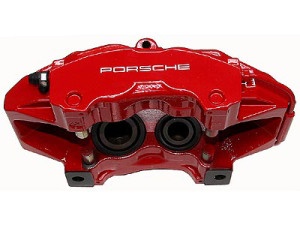I am going to discuss how to glue fake Brembo caliper covers to your vehicle. Actually, that’s a complete lie and I don’t recommend doing it. You’re not fooling anybody.
 This blog post is to touch base on how to service fixed position multi-piston brake calipers. My friend Brandon was lucky enough to buy his 1997 M3 with Porsche 996 non-turbo brake calipers (Commonly referred to as big reds) already installed. In addition, the standard E36 M3 brake rotors have been exchanged for front E46 M3 and rear E38 740Li brake rotors. From what I understand this is the most cost effective big brake upgrade you can do which requires little to no additional modification. When all is said and done parts cost is likely less than $1,500 (depending on how you source the calipers it could be much less) and you have a brake setup good enough for a weekend track day or autocross use.
This blog post is to touch base on how to service fixed position multi-piston brake calipers. My friend Brandon was lucky enough to buy his 1997 M3 with Porsche 996 non-turbo brake calipers (Commonly referred to as big reds) already installed. In addition, the standard E36 M3 brake rotors have been exchanged for front E46 M3 and rear E38 740Li brake rotors. From what I understand this is the most cost effective big brake upgrade you can do which requires little to no additional modification. When all is said and done parts cost is likely less than $1,500 (depending on how you source the calipers it could be much less) and you have a brake setup good enough for a weekend track day or autocross use.
What advantages do fixed position calipers hold over a traditional brake setup?
For one, big brake setups with multi-piston calipers offer improved brake performance under extreme conditions. They do this by increasing the brake surface area with the use of larger brake pads and brake rotors. This also has the added benefit for improved heat dissipation and reduced brake fade. In addition to improved performance by this type of brake setup I also find them to be much easier to service. An example of this is it’s not necessary to remove the brake caliper to replace the brake pads.
On my friend's BMW M3, we needed to use a special tool in order to compress the caliper pistons back into place to make room for the new brake rotors. Unlike a traditional 1 or 2 piston caliper with inboard pistons, (Floating caliper design) a fixed position caliper requires retracting all the pistons (inboard and outboard) at the same time. We used a special tool made by Lisle which is ideal for this task. It is designed to retract the brake caliper pistons with the brake caliper still mounted on the vehicle which is ideal if you were just going to replace the brake pads and not change the rotor.
What if I need to replace my rotors?
For the most part removing the brake caliper is straight forward and not much different than the stock brake setup. I simply removed the 16mm fasteners securing the caliper bracket to the wheel spindle and suspended the caliper assembly with an adjustable bungee cord. One area in which this brake caliper setup differs is there are no sliding pins. The caliper remains completely stationary over the rotor at all times. This means there is less hardware to service and replace making the job much simpler in comparison to a standard floating design.
Whether your vehicle came with these brakes from the factory or you upgraded after the fact the benefits of these braking systems are almost immediately apparent. They require less disassembly to service the brake system and also have the added benefit of significantly improved performance. If your vehicle has a fixed position brake setup I highly recommend looking into adding the following tool to your arsenal.
Quick Quad Brake Caliper Retractor Tool - Lisle 29100
[youtube=http://www.youtube.com/watch?v=PgN2P_oBQp0&w=560&h=315]
About the Author: Gareth Foley
Gareth runs the BMW catalog at FCP Euro, he can be reached at gareth@fcpeuro.com











